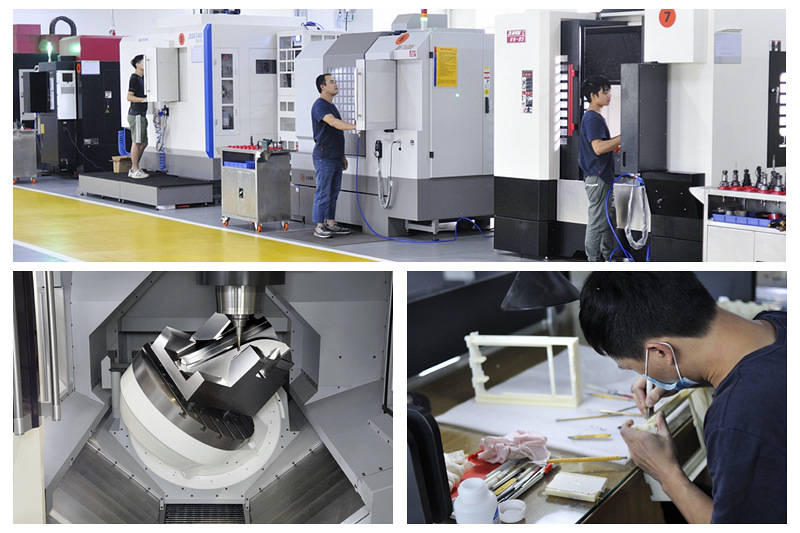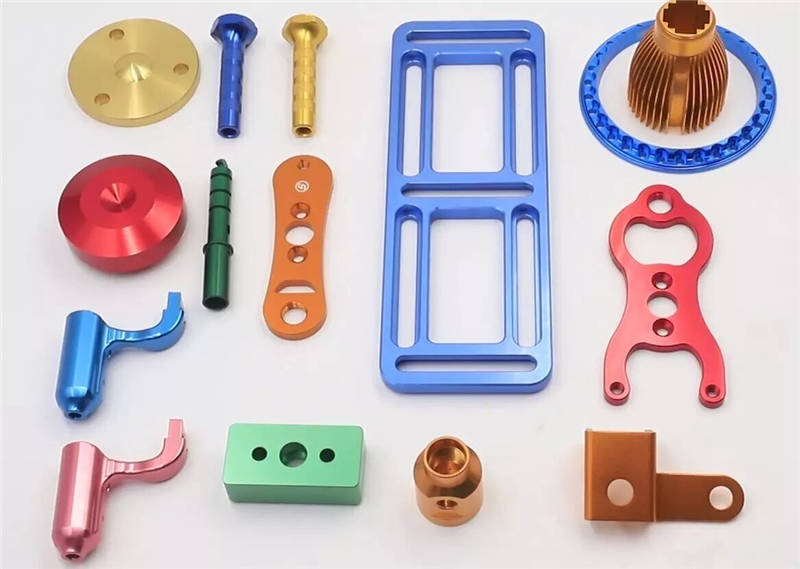
JY Machinery Specializes In CNC Machining Aluminum Anodized Parts,cnc aluminum parts
Experienced That Successfully Lead You from Prototype to Production
The surface treatment process of Aluminum is commonly used in anodization. Today, we will introduce the process of anodization.

Aluminum anodizing:
A. The chemical nature of aluminum is lively. A dense oxide film with a thickness of about 5um is immediately formed on the surface of aluminum in dry air, so that aluminum will not be further oxidized and can withstand water.
B. Aluminum is amphoteric, and it is easily soluble in strong alkali and dilute acid.
C. Put the aluminum and its alloy into the appropriate electrolyte as the anode for energization treatment. This treatment process is called anodization.
D. After anodizing, a porous honeycomb oxide film with a thickness of several to hundreds of microns can be formed on the aluminum surface.
Anodizing pretreatment:
1)Degreasing: reduce the adhesion of the oil film on the surface of the aluminum parts or even leave the surface, so that the surface oil stains can be easily removed in the next alkaline etching, and the alkaline etching is uniform.
Degreasing agent components: acidic degreasing agent 2% -3%, the main component of the bath is sulfuric acid (H2S04) or phosphoric acid (H3P04)
Bath temperature: room temperature
Degreasing time: 3 ~ 5min.
2)Alkali corrosion: The process of reacting with aluminum parts to remove surface dirt and remove the natural oxide film. The purpose is to activate the surface, and also remove the extrusion stripes to obtain different reflective surfaces.
Alkaline etching bath: sodium hydroxide (Na0h) solution, concentration 40 ~ 60g / L
Bath temperature: 40 ~ 80℃
Alkali etching time: 3 ~ 10s
3)Neutralization 1: Remove the dirt and ash from the surface after alkali etching to obtain a cleaner surface. At the same time, it can also neutralize the chemical reaction between the residual alkaline solution and the surface of aluminum parts.
Bath liquid composition: nitric acid (HNO3) solution, concentration 120 ~ 150g / L
Bath temperature: room temperature
Neutralization time: 5 ~ 15s
4)Electrolytic polishing: Using the effect of current to make the aluminum alloy react electrochemically, different degrees of deep solution occur on the uneven parts of the aluminum alloy surface, so that the aluminum surface has a smooth mirror effect. The electrolytically polished aluminum parts can still maintain most of the gloss after subsequent anodizing treatment. The high-purity aluminum sheet (99.99%) is electrolytically polished to obtain a mirror effect with a reflectivity close to 100%. The higher the purity of the aluminum sheet, the higher the reflectance.
Polishing liquid composition: phosphoric acid-chromic acid type, phosphoric acid-sulfuric acid, chromic acid type, phosphoric acid-sulfuric acid-glycerin type
Bath temperature: room temperature to 90℃,
Energized current density: 10 ~ 20A / dm2
Polishing time: 10 ~ 30s
5)Chemical polishing: Through the chemical ion reaction between aluminum and chemical polishing solution, different degrees of deep solution occur on the uneven parts of the aluminum alloy surface, which produces a gloss effect on the surface of aluminum parts.
Polishing bath composition: phosphoric acid 75% (volume fraction), nitric acid 15% (volume fraction), sulfuric acid 10% (volume fraction)
Bath temperature: 90 ~ 110℃
Polishing time: 5 ~ 15s
6)Neutralization 2: Remove stains and ash from the surface after polishing with an acidic solution to obtain a cleaner surface. At the same time, it can also neutralize the chemical reaction between the remaining acid solution and the surface of the aluminum parts.
Bath liquid composition: metal salt solution (copper sulfate CuSO4), concentration 100 ~ 150g / L
Bath temperature: room temperature
Neutralization time: 5 ~ 20s
Anodizing:
Aluminium or aluminum alloy products are used as anodes to be placed in an electrolyte solution to form an aluminum oxide film on the surface by electrolysis. When the current passes, hydrogen gas is released on the negative stage; the oxygen precipitated on the anode is not only molecular oxygen, but also atomic oxygen and ionic oxygen. Usually, the reaction is expressed by molecular oxygen. The aluminum as the anode is oxidized by the precipitated oxygen An anhydrous aluminum oxide film is formed. The pore diameter of the oxide film is about 0.01-0.03um. Not all of the generated oxygen interacts with aluminum, and part of it will be precipitated in gaseous form. There are three main ways of anodizing: sulfuric acid anodizing, hard anodizing, porcelain anodizing, mainly using sulfuric acid anodizing process.
Sulfuric acid anodizing
Bath liquid composition: The main component is sulfuric acid solution (H2S04), 150 ~ 180g / L AL ion: 5 ~ 15g / L
Bath temperature: 18 ~ 22
Oxidation voltage: 14 ~ 18V
Current density: 0.6 ~ 3 A / dm2
Oxidation time: 10 ~ 60 min, according to different products and colors to develop specific oxidation time
Oxide film thickness: According to different colors and process requirements, the oxide film thickness can be 5-50um. If an appropriate amount of oxalic acid solution is added to the solution, the toughness of the oxide film will be properly optimized.
Hard anodizing:
Hard anodizing is a process for forming thick and hard oxide films on the surface of aluminum and aluminum alloys.
The maximum thickness of the hard film can reach 250μm. The microhardness of the film layer formed on pure aluminum is 12000-15000MPa, and the alloy is generally 4000-6000MPa. It is almost the same as the hard chromium plating layer. The porosity of the hard film is about 20%, which is lower than that of the conventional sulfuric acid film.
Porcelain anodizing:
Porcelain anodizing refers to the anodization of aluminum and aluminum alloys in the solutions of titanium, zirconium or thorium salts of oxalic acid, citric acid and boric acid, and the hydroxide of the salt metal in the solution enters the pores of the oxide film , So that the surface of the product shows the treatment process with opaque and dense enamel or plastic-like appearance with special gloss. The process flow of porcelain anodizing is basically the same as that of conventional sulfuric acid anodizing. The difference is that porcelain anodizing is carried out at high DC voltage (115-125V) and high solution temperature (50-60 degrees). The electrolyte is often stirred 1. Adjust the pH value frequently to make it within the range of 1.6-2.
Dyeing:
The oxide film on the surface of the anodized aluminum part is placed in the dyeing solution so that the color molecules are absorbed in the pores of the anodized film. The pore diameter of the anodized film is about 0.01-0.03um, the dye separates single molecules in water, and the diameter is about 0.0015-0.0030um.
Dyeing method: divided into hot dyeing and cold dyeing. Thermal dyeing is used for dyeing when the dyeing solution is heated. All oxide films adsorb dye molecules quickly, but the time precision is high and it is difficult to control, so cold dyeing is usually used.
Bath composition: organic dye solution, test PH value according to different brands of dyes
Bath temperature: normal temperature
Oxidation time: 5 ~ 50 min, according to different products and colors to develop specific dyeing time
Sealing:
After the fresh anodized film is treated in boiling water or hot water close to boiling point for a certain period of time, it loses its activity, no longer absorbs the dye, and the dyed color is not easy to fade. This process is sealing.
Sealing method: high temperature sealing, medium temperature sealing, low temperature sealing, considering the cost and technical difficulty and other factors, the main use is now low temperature sealing.
Bath composition: low temperature nickel sealing agent solution, Ni ion: 0.8 ~ 1.2g / L, F ion: 0.35 ~ 0.6g / L, PH value: 5.6 ~ 6.5
Bath temperature: 20 ~ 30℃
Sealing time: 10 ~ 30 min, according to different products and colors to develop specific sealing time